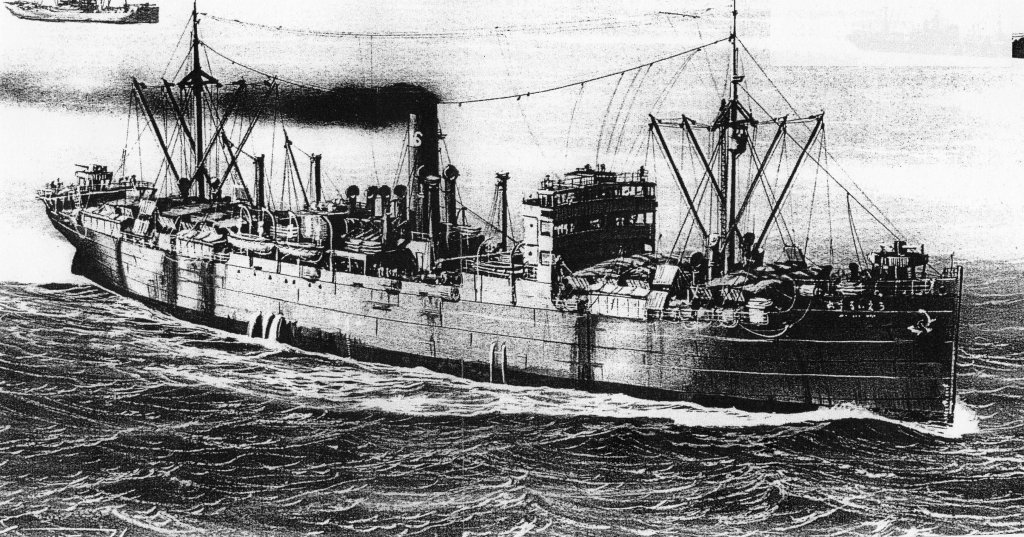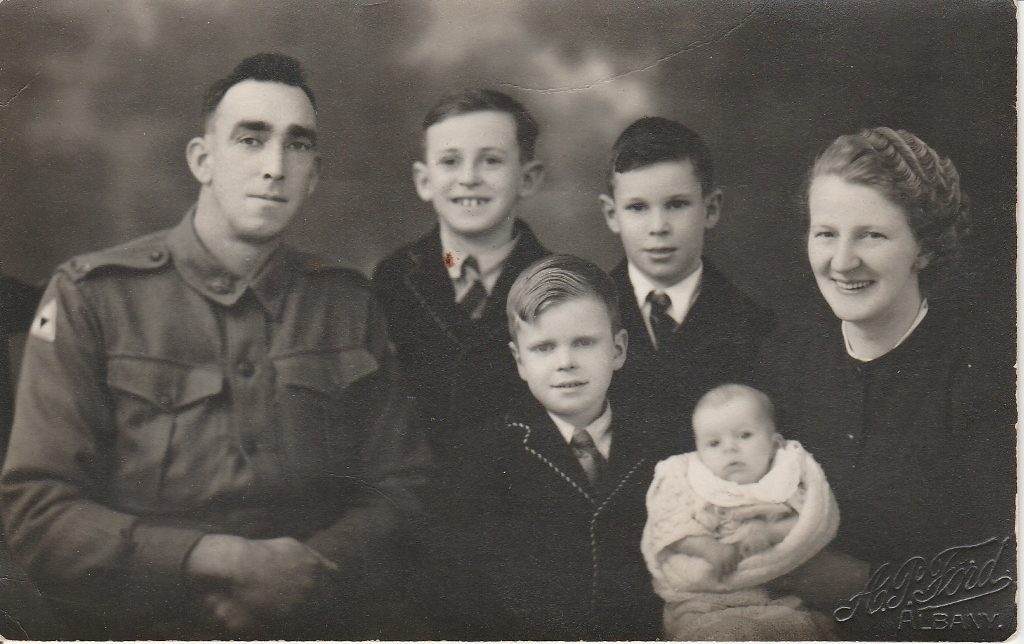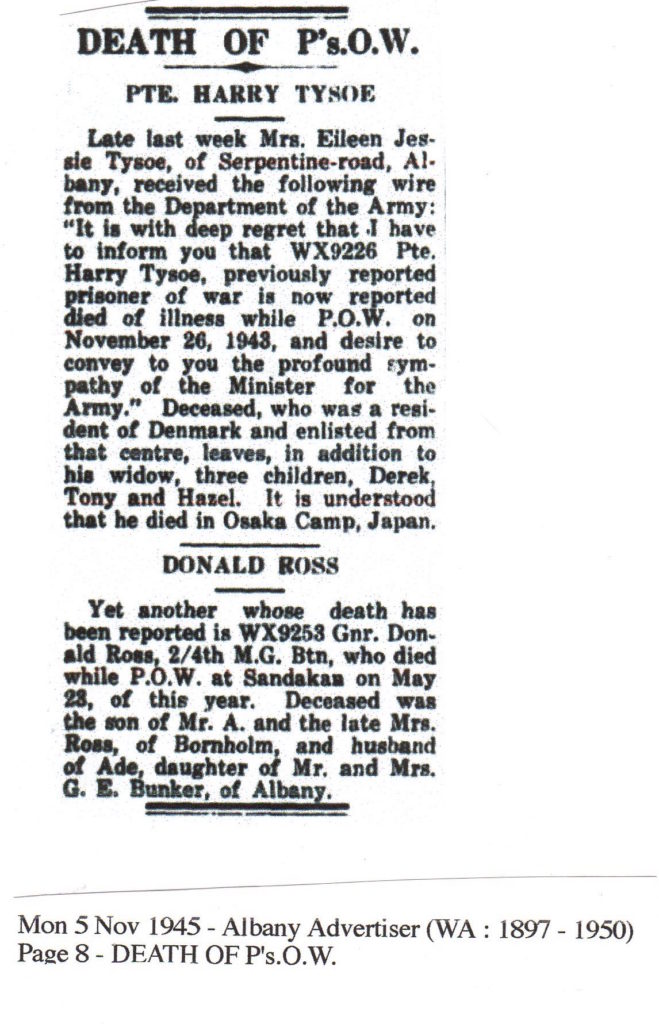‘Sparrow’
Harry Tysoe, born in England in 1908, emigrated to Australia in 1912. Here he grew up on a Group Settlement farm, west of Denmark, the fourth eldest of eight boys.
He enlisted at Claremont, October 30 1940 as a 32 year old, leaving behind his pregnant wife and three children. Harry went on to train at Northam becoming a member of the 2/4th Machine Gun Battalion December 16 1940. Training continued for the battalion for the next year at Northam, Woodside South Australia and Darwin until embarkation on the Aquatania via Port Moresby Sunday January 4 1942 bound for Singapore via Sydney and Fremantle.
‘Sparrow’, as he was known, had leave with his family for the last time July 1941, where he was able to welcome his new daughter Hazel, born May 22nd.
Thursday January 15 1942, Harry, one of 860 homesick Western Australians, was refused leave from the Aquatania anchored in Gage Roads, Fremantle. Many of his mates were to find whatever means they could to get to shore to spend there last hours with their loved ones before departure for war. It is unknown what Harry ‘s position was. It is assumed that as his nearest family were 250 miles away, he stayed aboard the Aquatania. The Aquatania took the men to the Sunda Straits where they were transshipped to small Malaysian freighters which took them on to Singapore.
The 2/4th arrived in Singapore, Saturday January 25 1942. It was Japanese routine to bomb Singapore at precisely 11.00am. By sheer luck the bombers did not come on the day of the 2/4th’s landing. The men were taken to Woodlands Camp on the north west of Singapore going into action February 8 1942 with the Japanese for the first time. After a week, Singapore fell to the Imperial Japanese army. Harry’s battalion suffered severe casualties. Out of 966, 137 men had been killed with others dying later of their wounds.
Harry was now a prisoner of the Japanese, 1 of 130,000 fellow P’sOW. After capitulation the men were marched to Changi and when the civilian gaol was full, those left were housed in Selerang Barracks, former peace time home of the Gordon Highlanders. Harry was to call the different camps of Johore Bahru, Adam Park and Selarang Barracks Changi his home for the next 16 months where he would have joined other fellow P’sOW working in work parties such as salt water, garden and firewood parties.
May 15 1943, Harry along with some 500 British and 300 Australians (20 men of the 2/4th) formed ‘J’ Force and were loaded on the Weills Maru (Wales Maru) bound for Japan. They were the men who were left in Changi after the exodus of the major working parties to Burma, Borneo and Thailand.

The convoy, including the Weills Maru, headed north. Confined to the holds, it was a real break for the POW’s to be allowed up to collect meals and the occasional hose down with seawater. The ship was a very old and very slow tramp steamer of about 6000 tons. The trip took 23 days, calling at Saigon and Taiwan, managing to survive a torpedo attack. But with engines damaged by depth charges, it lost the convoy and completed the rest of the journey on its own as a prime target. It reached Moji Port, Kyushu, Japan June 7 1943 where the P’sOW were split up. Harry along with 250 other Australians was sent by train to Kobe.
Kobe House Camp was in two warehouses converted into barracks, about half a mile from the harbor with its wharves and factories. Buildings were dark, dirty and venomous, ill ventilated and crowded. Each man lived, ate and slept in his twenty seven inches of sleeping space.
The P’sOW soon found themselves contracted out to work in some of the many industries of the port of Kobe such as factories, iron foundries, shipbuilding yards, stevedoring companies and various warehouses.
As October and November arrived so did heavy colds and influenza. November 1943 saw the only death of a 2/4th machine gunner from Kobe House, Harry, he was 35. Little did he know that his 9 year old son had been killed by a falling tree two months earlier. Harry had been admitted into hospital on November 7 suffering from influenza and acute beri-beri. He passed away November 26 as a result of progressive cardiac failure and beri-beri. His body was cremated at Kobe and his ashes were kept, along with other P’sOW remains, by a kind priest at a temple called Juganji, in Osaka. This temple was later moved to the outskirts of the city after the war.
His remains are said to have been re-inturned at Yokahama War Cemetery – Japan at Plot B Row A Grave 14.
Harry’s family were not to find out his fate for another 2 years. The following newspaper clipping appeared in the local paper Monday November 5 1945.


